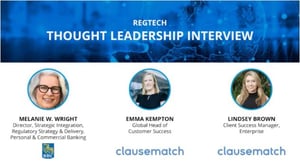Recently, my Clausematch colleagues Emma Kempton, Global Head of Customer Success and Lindsey Brown, Customer Success Manager, North America, were joined by our customer Melanie Wright, Director, Strategic Integration, Regulatory Strategy & Delivery, Personal & Commercial Banking, at Royal Bank of Canada (RBC), for a conversation with Fintech Global on the role of RegTech and compliance in today’s world, where business interactions are happening online more often than not and new regulations are released on a daily basis. I will share some of the valuable insights from this 30-minute interview, but you are, of course, more than welcome to watch the full video here.
The evolution of compliance - and RegTech
According to Melanie, and I’m sure we can all agree with her, compliance is not a side desk job anymore. Rightfully, in the past 10 years or so, it has been receiving a lot more attention, accompanied by a rise in hires and investment in technology. As with most functions, compliance is increasingly going digital, not only to drive cost-efficiency but also to make it possible to prove compliance.
“I see the future of RegTech as pretty much limitless”, says Melanie. With the ever-increasing stream of new regulations across different geographies and industries, the possibilities for the application of technology are virtually endless. Companies can’t afford to rely solely on the human element, siloed across different lines of business, to drive compliance. A digital solution is paramount to link all the pieces together and help regulated organisations achieve today’s far bigger compliance goals and requirements.
The sheer volume of new regulations in Canada, where Melanie is based, can be overwhelming for compliance professionals. Sometimes, there’s little notice to prepare before they are released. This forces digital adoption in the function, as it is impossible to keep up with manual processes only.
RegTech companies, such as Clausematch, are building up on old, first generation technology, to allow compliance to offer a better internal customer experience for their stakeholders and communicate what needs to be done. It is helping consolidate information across different lines of business and breaking down organisational silos.
On RegTech adoption challenges, Melanie explained that the biggest barrier can be the lack of willingness to change the ways things are done. Friction between compliance, an area that doesn’t make the money but rather spends it, and the money-making functions can also happen but it is important that companies stay out of trouble. If they don’t properly fund and resource compliance, at some point the bill will arrive, and it will be much higher.
How companies of different sizes work with RegTech providers
“Regardless of their size, companies adopt policy management technology to achieve their business goals, but a RegTech provider can’t have a one-size-fits-all approach. We need to understand how each customer wants to work and make it happen”, says Emma. While bigger companies have dedicated implementation resources, in smaller companies, oftentimes, people need to wear many hats and juggle conflicting projects. Smaller companies also look to RegTech partners for reassurance on what they are doing. “Enterprises strive to be best-in-class, they bring suggestions that can help our team prioritise our product roadmap”, adds Lindsey.
Drivers for the adoption of policy management technology
Companies adopt policy management technology for what it allows them to achieve in their businesses, says Emma. They are usually looking for the following outcomes:
- Having all documents in one place and making sure all staff has access to a single version of the truth
- Making it easy for people across the organisation to collaborate to create, edit and approve documents, whilst keeping an audit trail that shows exactly what has been done
- Allowing people to see the policies. There’s no point in having a policy that is hidden. They want people to understand them and weave them into their day-to-day tasks.
Lindsey has recently seen a huge interest in API integrations and the metadata that can be pulled from it. Being able to access the metadata and build reports to meet simple 2-week audits is a sought-after feature for US and Canadian companies.
Customer relationships in the Zoom era
The pandemic brought multiple challenges and not being able to meet customers face to face was one of them. Although nothing beats in-person interaction, Emma noticed some positive aspects. According to her, people opened up a bit more and showed little insights on their personal lives.
Even though relationships were formed in a different way, she believes that the key factors to build good customer relationships remained the same: timely and efficient communication, demonstrating that their success is important to Clausematch and that their ideas and concerns are taken seriously.
Adapting to each customer’s preferences is also key, with some preferring new channels, such as Slack or Monday.com, while others prefer the more traditional emails and recurring meetings.
Relationships were forged with people we have never met in person, across different time zones, and companies have developed an even more global perspective. “People couldn’t rely on face to face and had to make it all happen in front of a camera. Now we know it can be done”, added Melanie.
For more insights into this topic, view the full video here.
.jpg?width=290&name=Carol_blog%20(1).jpg)
